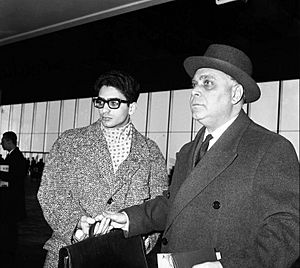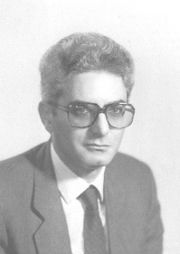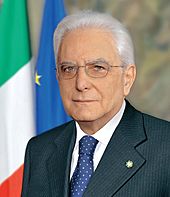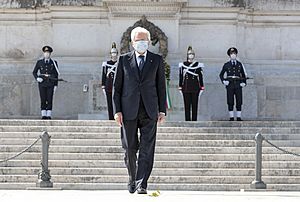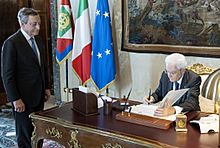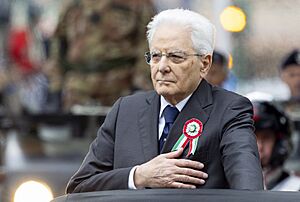Sergio Mattarella facts for kids
Quick facts for kids
Sergio Mattarella
OMRI OMCA
|
|
|---|---|
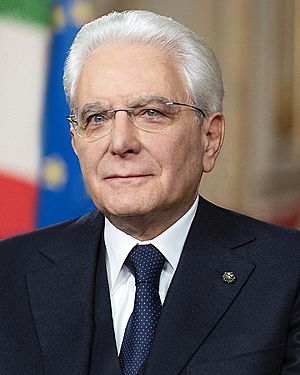
Official portrait, 2022
|
|
| President of Italy | |
| Assumed office 3 February 2015 |
|
| Prime Minister | |
| Preceded by | Giorgio Napolitano |
| Judge of the Constitutional Court of Italy | |
| In office 11 October 2011 – 2 February 2015 |
|
| Appointed by | Italian Parliament |
| Preceded by | Ugo De Siervo |
| Succeeded by | Augusto Antonio Barbera |
| Minister of Defence | |
| In office 22 December 1999 – 11 June 2001 |
|
| Prime Minister | Massimo D'Alema Giuliano Amato |
| Preceded by | Carlo Scognamiglio |
| Succeeded by | Antonio Martino |
| Deputy Prime Minister of Italy | |
| In office 21 October 1998 – 22 December 1999 |
|
| Prime Minister | Massimo D'Alema |
| Preceded by | Walter Veltroni |
| Succeeded by | Gianfranco Fini |
| Minister of Public Education | |
| In office 23 July 1989 – 27 July 1990 |
|
| Prime Minister | Giulio Andreotti |
| Preceded by | Giovanni Galloni |
| Succeeded by | Gerardo Bianco |
| Minister for Parliamentary Relations | |
| In office 29 July 1987 – 23 July 1989 |
|
| Prime Minister | Giovanni Goria Ciriaco De Mita |
| Preceded by | Gaetano Gifuni |
| Succeeded by | Egidio Sterpa |
| Member of the Chamber of Deputies | |
| In office 12 July 1983 – 28 April 2008 |
|
| Constituency |
See list
Palermo (1983–1994)
Sicily 1 (1994–2001; 2006–2008) Trentino-Alto Adige (2001–2006) |
| Personal details | |
| Born | 23 July 1941 Palermo, Italy |
| Political party | Independent (since 2009) |
| Other political affiliations |
|
| Spouse |
Marisa Chiazzese
(m. 1966; died 2012) |
| Children | 3, including Laura |
| Parent |
|
| Relatives | Piersanti Mattarella (brother) |
| Residence | Quirinal Palace |
| Alma mater | Sapienza University of Rome |
| Signature | |
Sergio Mattarella (born 23 July 1941) is an Italian politician who has been the President of Italy since 2015. He is the longest-serving president in the history of the Italian Republic. The President of Italy is like a head of state, similar to a king or queen in some countries, but elected. They make sure the country's rules (the Constitution) are followed and help keep things stable.
Mattarella was a key member of the Christian Democracy party for many years. He served as a minister in different governments, including Minister for Parliamentary Relations (1987–1989), Minister of Education (1989–1990), Deputy Prime Minister (1998–1999), and Minister of Defence (1999–2001). Before becoming president, he was also a judge on the Constitutional Court of Italy from 2011 to 2015.
On 31 January 2015, Mattarella was elected president. He was re-elected on 29 January 2022, becoming only the second Italian president to serve a second term. During his time as president, Italy has faced big challenges like the COVID-19 pandemic and economic difficulties.
Contents
Early Life and Family
Sergio Mattarella was born in Palermo, Italy, on 23 July 1941. He came from an important Sicilian family. His father, Bernardo Mattarella, was a politician who helped start the Christian Democracy party. This party was very important in Italian politics for almost 50 years.
Sergio Mattarella studied law at the Sapienza University of Rome. After finishing his studies, he became a lawyer in Palermo and later taught law at the University of Palermo.
A very sad event changed Mattarella's life. On 6 January 1980, his older brother, Piersanti Mattarella, who was also a politician, was killed by the Sicilian Mafia in Palermo. After this, Sergio Mattarella decided to leave his teaching career and enter politics to fight against organized crime.
Political Career Highlights
Mattarella began his career in the Chamber of Deputies (one part of the Italian Parliament) in 1983. He was known for being part of the left-leaning group within his party. He worked to clean up politics in Sicily, which was heavily influenced by the Mafia at the time. He helped Leoluca Orlando become the new mayor of Palermo, and together they worked to reduce the Mafia's power.
Serving as a Minister
Mattarella held several important government jobs. From 1987 to 1989, he was the Italian Minister for Parliamentary Relations. This role involves working between the government and the Parliament.
In 1989, he became the Italian Minister of Education. He worked on reforming schools and improving teaching programs. He also helped pass a law that included health education in schools. He resigned from this role in 1990 because he disagreed with a new law about media.
After his party changed its name to the Italian People's Party (PPI), Mattarella continued to be an important figure. He helped create a new election law called Mattarellum, which combined different ways of voting.
Later, he became Deputy Prime Minister of Italy from 1998 to 1999. In this role, he was also in charge of the secret services and tried to reform them. From 1999 to 2001, he served as Italian Minister of Defence. During this time, he supported NATO actions in Yugoslavia and ended the rule that made military service mandatory in Italy.
Judge of the Constitutional Court
In 2011, Mattarella was chosen by the Italian Parliament to be a judge on the Constitutional Court of Italy. This court makes sure that laws follow the Italian Constitution. He served in this important role until he became President in 2015.
Presidency (2015–Present)
First Term (2015–2022)
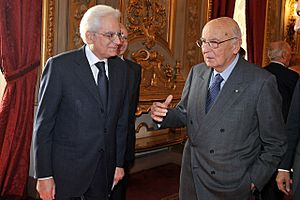
Sergio Mattarella was elected President of Italy on 31 January 2015. He took his oath on 3 February 2015. His first words as president were about the "difficulties and hopes of our fellow citizens." One of his first actions was to visit the Fosse Ardeatine, a place where many people were killed during World War II. He said that the world must unite to fight against terror.
Political Challenges
During his first term, Mattarella faced several political challenges. In 2016, there was a constitutional referendum (a public vote on a new law) about changing the Italian Constitution. The changes were rejected by voters, and the Prime Minister, Matteo Renzi, resigned. Mattarella then appointed Paolo Gentiloni as the new Prime Minister.
2018 Government Formation
After the 2018 general election, it was very difficult to form a new government because no party or group had a clear majority. Mattarella had to hold many meetings with party leaders to find a solution.
Eventually, the Five Star Movement (M5S) and the League agreed to form a government. They suggested Giuseppe Conte as Prime Minister. However, there was a disagreement when the League wanted to appoint a specific minister who was seen as against the Euro (Italy's currency). Mattarella refused this appointment, saying he had to protect Italy's stability and its place in Europe. This caused a big political crisis, but eventually, a government led by Giuseppe Conte was formed.
COVID-19 Pandemic
A major event during Mattarella's presidency was the COVID-19 pandemic. In early 2020, Italy was one of the first Western countries to be hit hard by the virus. The government had to put the whole country into a national lockdown to stop the spread.
Mattarella often spoke to the nation, encouraging people and emphasizing the importance of unity and following health rules. He strongly supported vaccination efforts. In his last speech of his first term, on 31 December 2021, he thanked Italians for getting vaccinated and for showing the "best face of the country."
Second Term (2022–Present)

Even though Mattarella had said he didn't want a second term, political parties couldn't agree on a new president. So, they asked him to stay, and he agreed. He was re-elected on 29 January 2022, with a large number of votes.
In his second term, Mattarella continued to emphasize unity and Italy's role in Europe. He strongly condemned the Russian invasion of Ukraine, calling it a "brutal war."
2022 Government Crisis
In July 2022, another government crisis happened when the Five Star Movement withdrew its support from Prime Minister Mario Draghi's government. Draghi resigned, but Mattarella initially asked him to speak to Parliament to try and resolve the situation. When Draghi's government still couldn't get enough support, Mattarella accepted his resignation and called for new elections.
New Government and Recent Events
The new elections in September 2022 led to the centre-right coalition winning a majority. Mattarella then asked Giorgia Meloni, the leader of the Brothers of Italy party, to form a new government. She became Italy's first female Prime Minister.
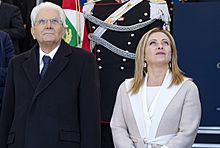
Mattarella continues to play an important role in guiding Italy. He has spoken out on various issues, including the need for police to protect freedom of expression during protests and the importance of voting in European elections. He has consistently supported Italy's strong ties with Europe and its allies.
Electoral History
| Election | House | Constituency | Party | Votes | Result | |
|---|---|---|---|---|---|---|
| 1983 | Chamber of Deputies | Palermo–Trapani–Agrigento–Caltanissetta | DC | 119,969 | ||
| 1987 | Chamber of Deputies | Palermo–Trapani–Agrigento–Caltanissetta | DC | 143,935 | ||
| 1992 | Chamber of Deputies | Palermo–Trapani–Agrigento–Caltanissetta | DC | 50,280 | ||
| 1994 | Chamber of Deputies | Sicily 1 | PPI | – | ||
| 1996 | Chamber of Deputies | Sicily 1 | PPI | – | ||
| 2001 | Chamber of Deputies | Trentino-Alto Adige/Südtirol | DL | – | ||
| 2006 | Chamber of Deputies | Sicily 1 | Ulivo | – | ||
Presidential Elections
| 2015 presidential election (4th ballot) | ||||
|---|---|---|---|---|
| Candidate | Supported by | Votes | % | |
| Sergio Mattarella | PD, NCD, SC, UDC, SEL | 665 | 65.9 | |
| Ferdinando Imposimato | M5S | 127 | 12.5 | |
| Others | 85 | 8.4 | ||
| Blank or invalid votes | 118 | 11.6 | ||
| Abstentions | 14 | 1.3 | ||
| Total | 1,009 | 100.0 | ||
| 2022 presidential election (8th ballot) | ||||
|---|---|---|---|---|
| Candidate | Supported by | Votes | % | |
| Sergio Mattarella | M5S, Lega, PD, FI, IV, CI, LeU, Aut, Az, +Eu | 759 | 75.2 | |
| Carlo Nordio | FdI | 90 | 8.92 | |
| Nino Di Matteo | Alt | 37 | 3.7 | |
| Others | 59 | 5.8 | ||
| Blank or invalid votes | 38 | 3.8 | ||
| Abstentions | 26 | 2.6 | ||
| Total | 1,009 | 100.0 | ||
Honours and Awards
Sergio Mattarella has received many awards and honours from Italy and other countries around the world. These awards recognize his important work and leadership.
Italian Honours
- Head and Grand Cross with Collar of the Order of Merit of the Italian Republic (since 2015)
- Head of the Military Order of Italy (since 2015)
- Head of the Order of Merit for Labour (since 2015)
- Head of the Order of the Star of Italy (since 2015)
- Recipient (gold medal) of the Italian Order of Merit for Culture and Art (1991)
- Grand Cross of the Order of Merit of the Italian Red Cross (2019)
International Honours
 Algeria: Collar of the National Order of Merit (2021)
Algeria: Collar of the National Order of Merit (2021) Angola: Recipient of the Order of Agostinho Neto (2023)
Angola: Recipient of the Order of Agostinho Neto (2023) Argentina: Collar of the Order of the Liberator General San Martin (2017)
Argentina: Collar of the Order of the Liberator General San Martin (2017) Armenia: Grand Cross of the Order of Glory (2018)
Armenia: Grand Cross of the Order of Glory (2018) Austria: Grand Star of the Decoration of Honour for Services to the Republic of Austria (2019)
Austria: Grand Star of the Decoration of Honour for Services to the Republic of Austria (2019) Azerbaijan: Heydar Aliyev Order (2018)
Azerbaijan: Heydar Aliyev Order (2018) Belgium: Grand Cordon of the Order of Leopold (2021)
Belgium: Grand Cordon of the Order of Leopold (2021) Brazil: Grand Collar of the National Order of the Southern Cross (2024)
Brazil: Grand Collar of the National Order of the Southern Cross (2024) Bulgaria: Grand Cross of the Order of the Balkan Mountains (2016)
Bulgaria: Grand Cross of the Order of the Balkan Mountains (2016) Cameroon: Grand Cross of the Cameroon Order of Valour (2016)
Cameroon: Grand Cross of the Cameroon Order of Valour (2016) Cyprus: Grand Collar of the Order of Makarios III (2024)
Cyprus: Grand Collar of the Order of Makarios III (2024) Estonia: Collar of the Order of the Cross of Terra Mariana (2018)
Estonia: Collar of the Order of the Cross of Terra Mariana (2018) Finland: Grand Cross with Collar of the Order of the White Rose (2017)
Finland: Grand Cross with Collar of the Order of the White Rose (2017) France: Grand Cross of the Order of the National Order of the Legion of Honour (2021)
France: Grand Cross of the Order of the National Order of the Legion of Honour (2021) Germany: Grand Cross Special Class of the Order of Merit of the Federal Republic of Germany (2019)
Germany: Grand Cross Special Class of the Order of Merit of the Federal Republic of Germany (2019) Greece: Grand cross of the Order of the Redeemer (2015)
Greece: Grand cross of the Order of the Redeemer (2015) Ivory Coast: Grand Cross of the National Order of the Ivory Coast (2024)
Ivory Coast: Grand Cross of the National Order of the Ivory Coast (2024) Latvia: Commander Grand Cross with Chain of the Order of the Three Stars (2018)
Latvia: Commander Grand Cross with Chain of the Order of the Three Stars (2018) Lithuania: Grand Cross with Golden Chain of the Order of Vytautas the Great (2018)
Lithuania: Grand Cross with Golden Chain of the Order of Vytautas the Great (2018) Luxembourg: Knight of the Order of the Gold Lion of the House of Nassau (2025)
Luxembourg: Knight of the Order of the Gold Lion of the House of Nassau (2025) Malta: Honorary Companions of Honour with Collar of the National Order of Merit (2017)
Malta: Honorary Companions of Honour with Collar of the National Order of Merit (2017) Mexico: Collar of the Mexican Order of the Aztec Eagle (2016)
Mexico: Collar of the Mexican Order of the Aztec Eagle (2016) Montenegro: Member 2sd class of the Order of the Republic of Montenegro (2025)
Montenegro: Member 2sd class of the Order of the Republic of Montenegro (2025) Netherlands: Knight Grand Cross of the Order of the Netherlands Lion (2017)
Netherlands: Knight Grand Cross of the Order of the Netherlands Lion (2017) Norway: Grand Cross of the Royal Norwegian Order of Saint Olav (2016)
Norway: Grand Cross of the Royal Norwegian Order of Saint Olav (2016) Paraguay: Collar of the National Order of Merit (2023)
Paraguay: Collar of the National Order of Merit (2023) Poland: Knight of the Order of the White Eagle (2023)
Poland: Knight of the Order of the White Eagle (2023) Portugal: Grand Collar of the Order of Liberty (2017)
Portugal: Grand Collar of the Order of Liberty (2017) Qatar: Recipient of the Sword of the Founder Sheikh Jassim bin Mohammed bin Thani (2024)
Qatar: Recipient of the Sword of the Founder Sheikh Jassim bin Mohammed bin Thani (2024) Romania: Collar of the Order of the Star of Romania (2016)
Romania: Collar of the Order of the Star of Romania (2016) San Marino: Collar of the Order of San Marino (2021)
San Marino: Collar of the Order of San Marino (2021) Slovenia: Member of the Order for Exceptional Merits (2021)
Slovenia: Member of the Order for Exceptional Merits (2021) South Korea: Recipient of the Grand Order of Mugunghwa (2023)
South Korea: Recipient of the Grand Order of Mugunghwa (2023) Sovereign Military Order of Malta: Collar of the Order pro Merito Melitensi (2016)
Sovereign Military Order of Malta: Collar of the Order pro Merito Melitensi (2016) Spain:
Spain:
- Knight of the Collar of the Royal Order of Isabella the Catholic (2021)
- Knight of the Collar of the Royal and Distinguished Spanish Order of Charles III (2024)
 Sweden: Knight of the Royal Order of the Seraphim (2018)
Sweden: Knight of the Royal Order of the Seraphim (2018) United Arab Emirates: Collar of the Order of Zayed (2025)
United Arab Emirates: Collar of the Order of Zayed (2025) United Kingdom:
United Kingdom:
- Honorary Knight Grand Cross of the Most Honourable Order of the Bath (GCB) (2025)
- Honorary Knight Commander of the Most Excellent Order of the British Empire (KBE) (as Minister of Defence) (2000)
 Vatican City:
Vatican City:
- Knight with the Collar of the Order of Pope Pius IX (2015)
- Paul VI Prize (2023)
See also
 In Spanish: Sergio Mattarella para niños
In Spanish: Sergio Mattarella para niños


